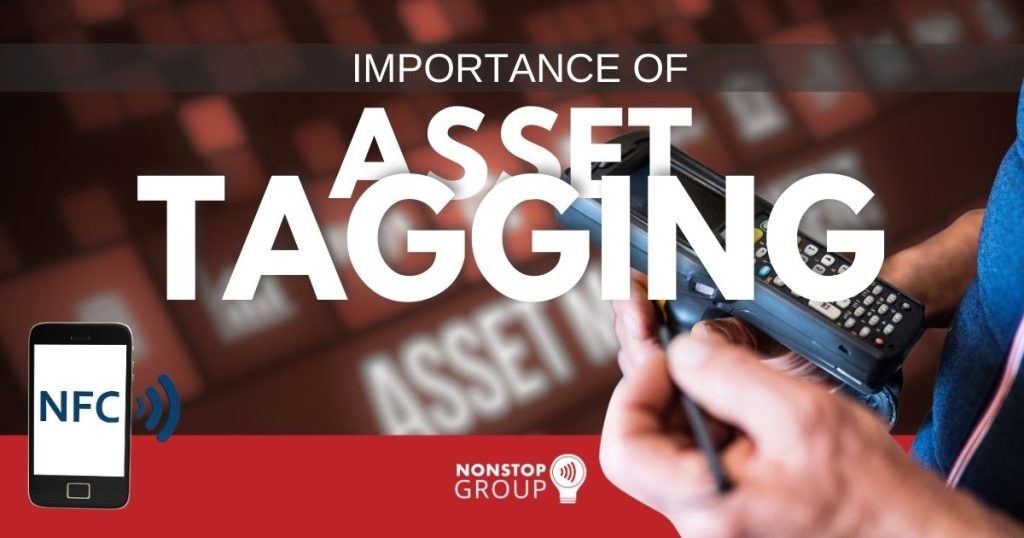6 Min Read

In this data-centric business landscape, efficient asset management is paramount for organizations striving to maintain a competitive edge. One crucial component of this strategy is asset tagging.
Asset tagging enables organizations to track and manage their assets with unparalleled precision. This not only ensures that assets are accounted for but also simplifies maintenance, reduces the risk of loss, and minimizes the chances of theft. According to a study by Auburn University, asset tagging systems can improve inventory accuracy from an average of 63% to over 95%. This leap in precision translates to reduced stockouts, optimized reorder points, and improved customer satisfaction.
In this blog post, we’ll dive into the significance of asset tagging and explore how it can revolutionize your asset management, increase productivity, and enhance your bottom line. Let’s dig in!
What is Asset Tagging?
In an asset-intensive organization, knowing the precise location, condition, and status of assets at any given time is imperative. Asset tagging, also known as asset labeling, is a system that helps in efficient asset management and tracking.
Typically in the form of barcodes, QR codes, RFID tags, or Near Field Communication (NFC) asset tracking, these identifiers create a vital link between the physical asset and its digital counterpart within an organization’s asset management system. This asset tag typically contains essential information like the asset’s name, location, and other relevant details.
Asset labeling streamlines inventory control, maintenance, and asset tracking. When an asset is needed, its label is scanned or read. The asset data can then be quickly identified, retried and accessed on a Computerized Maintenance Management System (CMMS). It also aids in preventive maintenance scheduling and auditing. Consequently, organizations can optimize resource allocation and reduce the risk of loss or mismanagement.
PRO TIP
Integrating The NonStop Suite for efficient asset tagging and tracking is undeniably a game-changer for businesses seeking to streamline their operations. This powerful suite not only simplifies the process of tagging and tracking assets but also ensures their continuous monitoring and management. Thus minimizing the risk of asset losses, theft, and inefficiencies.
Smarter Asset Tracking With NFC Tags
Learn more about how NonStop Suite's NFC Asset Tracking Solution can help your Enterprise streamline operations to new heights.
Get A Free Product Tour
What are the Features of Asset Tracking Software?
Asset tagging encompasses a host of features that fortify an organization’s asset performance management capabilities. Detailed below are some of these critical features that organizations can leverage to streamline asset maintenance management:
- Unique Identification: Asset tags offer a distinctive identification system, ensuring that no two assets share the same identifier. This uniqueness is crucial for pinpoint accuracy in asset tracking.
- Labels or Barcodes:Asset labels typically include labels with essential information or barcodes that can be scanned with handheld devices. These elements make it simple to access asset details quickly.
- NFC Technology:Some asset tagging procedures utilize Near-field Communication (NFC) tags and readers technology. NFC tags can be read remotely, allowing for efficient tracking and reduced manual labor in asset management.
- Durability:Asset tags are engineered to withstand environmental factors, including temperature variations, moisture, and physical wear and tear. This efficacy ensures that all current and fixed assets remain intact and legible.
- Data Recording: Asset tags may include asset name, location, purchase date, warranty details, and other relevant asset data. This information can be recorded in a central databasefor easy retrieval.
- Customization:Asset tags can be customized to suit an organization’s specific needs, including the choice of materials, sizes, and information to be included on the label.
- Integration with Asset Management Software: Asset tagging tools often integrate with asset management software. This enables real-time updates, tracking, and reporting, streamlining asset management processes.
- Asset Tracking and Maintenance: Beyond identification, asset tags assist in tracking asset movements, maintenance schedules, and depreciation. This efficient system aids in decision-making regarding repairs, replacements, or upgrades.
- Compliance Support: Asset tagging operations can assist organizations in meeting regulatory and financial compliance requirements by providing accurate asset records.
PRO TIP
Integrate The NonStop Suite into your asset management strategy and enhance the efficiency of audits and compliance reporting. This powerful solution simplifies the process of identifying and verifying assets, which is particularly critical in regulated industries where stringent record-keeping is imperative.
What Type of Assets Can Be Tagged?
Asset tagging can be tailored to an organization’s specific needs and its industry. It is crucial in enhancing asset management, reducing losses, ensuring compliance, and optimizing resource allocation across various asset types.
Detailed below is a versatile practice applicable to a wide range of asset types, including:
- IT Equipment:Computers, servers, laptops, and peripherals benefit from tagging assets to track their location, maintenance, and software licenses.
- Furniture and Fixtures:Offices and institutions can label desks, chairs, cabinets, and equipment, facilitating inventory management and rearrangement.
- Vehicles:Asset tagging process is essential for fleets of cars, trucks, and heavy machinery, assisting in maintenance scheduling and monitoring.
- Medical Equipment:In healthcare settings, asset tagging ensures that crucial medical devices are readily accessible and well-maintained.
- Manufacturing Equipment:Manufacturers can tag assets, machinery and tools to optimize production processes and reduce downtime.
What is the Purpose of Asset Tagging?
Asset tagging, a meticulous process of affixing unique labels or identifiers to physical assets, facilitates seamless integration into an organization’s management system.
The primary purpose of asset tagging is to establish a systematic and organized method for tracking and managing assets throughout their lifecycle. It enhances accountability by providing a straightforward means of identification, reducing the risk of misplacement or theft.
Moreover, it facilitates inventory control, enabling organizations to monitor the quantity and condition of their assets. This, in turn, helps streamline maintenance schedules and minimize downtime.
6 Benefits of Asset Tags for Asset-Intensive Organizations
Asset tagging represents an invaluable practice for asset-intensive organizations. When executed systematically and consistently, a smart asset tracking system offers the following benefits that contribute to the efficiency, safety, and overall asset management within an organization:
Improved Asset Tracking
Asset tagging revolutionizes asset tracking. It furnishes organizations with the capability to pinpoint an asset’s precise location, status, and a comprehensive historical record at their fingertips. This granular tracking capability enhances operational transparency and offers a powerful tool for reducing downtime and optimizing asset utilization.
These technology-driven tags are instrumental in asset-intensive sectors such as manufacturing and logistics, where assets are dispersed across extensive facilities. Asset tagging empowers real-time asset monitoring, ensuring that no asset remains shrouded in obscurity. It enables timely interventions in case of malfunctions. Thus contributing to a more robust and efficient asset management framework.
Enhanced Security and Safety Compliance
When integrated with security protocols, asset tagging becomes a powerful deterrent against unauthorized access and theft. This is particularly crucial in asset-intensive industries like construction and manufacturing, where valuable equipment and materials are abundant.
Asset tagging serves as a guardian on job sites, ensuring the protection of physical assets and, in the modern context, data security. This is facilitated by the seamless integration of asset tags with data tracking systems, reinforcing the overall safety and security of these environments.
Safety compliance is another domain where asset tagging is crucial, particularly in industries like healthcare. By tagging medical equipment and devices, regulatory adherence becomes not only attainable but effortless.
This system ensures patient safety by providing the quick and accurate availability and maintenance of essential medical tools. It underscores the healthcare industry’s dedication to the well-being of patients, ultimately safeguarding lives.
Streamlined Maintenance and Repairs
Asset maintenance is the lifeblood of asset-intensive industries. Asset tagging streamlines this process by creating meticulous maintenance schedules, recording repair histories, and forecasting replacements. Organizations can precisely monitor assets and detect anomalies that might lead to costly downtimes.
This maintenance method goes beyond reactive maintenance practices and delves into proactive maintenance. Consequently, organizations are facilitated with condition-based maintenance strategies.
Enhanced Asset Lifecycle Management
The cradle-to-grave journey of an asset is a complex narrative in asset-intensive industries with numerous regulatory implications. Asset tagging serves as the central element in this narrative. It allows organizations to monitor and document an asset’s lifecycle from acquisition to disposal.
This meticulous tracking ensures compliance with regulations, including environmental stewardship, which is increasingly pertinent today. Asset managers can effectively demonstrate asset retirement and replacement strategies, reducing their ecological footprint. Thus, asset tagging extends beyond efficiency; it becomes a corporate responsibility, resonating with a world increasingly sensitive to environmental concerns.
Better Equipment Inventory Management
Asset tagging revolutionizes equipment inventory management, providing an optimal level of precision. This approach empowers organizations to systematically categorize, classify, and monitor their equipment inventory. Its advantages extend to efficient resource allocation and streamlined project planning.
Asset-intensive industries often require optimal equipment allocation for various projects. Asset tagging permits organizations to distinguish between underutilized and overworked assets, ensuring that resources are channeled efficiently. This, in turn, leads to an enhancement of operational agility, a cornerstone of competitive advantage in the asset-intensive landscape.
Reduces Costs Associated With Job Site Theft
Job site theft has been a persistent problem in asset-intensive industries. The financial implications of job site theft can be substantial, and asset tagging offers robust mitigation. Asset tagging is a strong defense by making assets easily traceable and discouraging potential thieves.
In the unfortunate event of theft, tagged assets become recoverable. This recovery not only saves on replacement costs but also minimizes the consequential delays and disruptions that can be financially crippling. Thus, asset tagging emerges as a guard against the loss of assets and revenue.
PRO TIP
Integrate The NonStop Suite for efficient asset tagging and tracking to quickly identify the maintenance history, service requirements, and replacement schedules. Ultimately, it promotes accountability, efficiency, and compliance while safeguarding your organization’s investments and resources.
The Future of Asset Management is Called The Nonstop Suite!
Embracing asset tags is not just a matter of convenience. It’s a strategic move that can set your organization to ensure your assets are tracked effectively every step of the way. To cater to this need, The NonStop Group presents The NonStop Suite — the ultimate asset tagging system for regulated industries and asset-intensive organizations!
By harnessing the capabilities of NonStop Suite, organizations can experience a significant boost in productivity, accuracy, and cost-effectiveness. From manufacturing facilities to logistics operations, the suite provides a comprehensive solution that enables real-time asset visibility into asset locations, usage, and maintenance requirements. This newfound control empowers businesses to make data-driven decisions, reduce downtime, and optimize resource allocation.
Should your organization want to optimize asset tagging and tracking, it’s time to consult The NonStop Group. Book your FREE personalized product tour today and discover a world of possibilities for your business.

